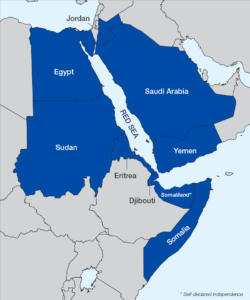In News: Recently, An Iranian cargo ship to be a base for the paramilitary Islamic Revolutionary Guard Corps (IRGC) and anchored for years in the Red Sea off Yemen has been attacked.
About Red Sea

- Red Sea, Arabic Al-Baḥr Al-Aḥmar, narrow strip of water extending southeastward from Suez, Egypt, for about 1,200 miles (1,930 km) to the Bab el-Mandeb Strait, which connects with the Gulf of Aden and thence with the Arabian Sea.
- Geologically, the Gulfs of Suez and Aqaba (Elat) must be considered as the northern extension of the same structure.
- The sea separates the coasts of Egypt, Sudan, and Eritrea to the west from those of Saudi Arabia and Yemen to the east.
- With its connection to the Mediterranean Sea via the Suez Canal, it is one of the most heavily traveled waterways in the world, carrying maritime traffic between Europe and Asia.
- Its name is derived from the colour changes observed in its waters. Normally, the Red Sea is an intense blue-green; occasionally, however, it is populated by extensive blooms of the algae Trichodesmium erythraeum, which, upon dying off, turn the sea a reddish brown colour.
Physiography
- The Red Sea lies in a fault depression that separates two great blocks of Earth’s crust—Arabia and North Africa.
- At its northern end the Red Sea splits into two parts, the Gulf of Suez to the northwest and the Gulf of Aqaba to the northeast.
- topography of the trough becomes more rugged, and several sharp clefts appear in the seafloor
- The sill (submarine ridge) separating the Red Sea and the Gulf of Aden at the Bab el-Mandeb Strait.
- At the bottom of these areas are unique sediments, containing deposits of heavy metal oxides from 30 to 60 feet thick.
Geology
- The Red Sea occupies part of a large rift valley in the continental crust of Africa and Arabia.
- This break in the crust is part of a complex rift system that includes the East African Rift System, which extends southward through Ethiopia, Kenya, and Tanzania and northward from the Gulf of Aqaba to form the great Wadi Aqaba–Dead Sea–Jordan Rift; the system also extends eastward from the southern end of the Red Sea to form the Gulf of Aden.
- The Red Sea is considered a relatively new sea, whose development probably resembles that of the Atlantic Ocean in its early stages.
Hydrology
- No water enters the Red Sea from rivers, and rainfall is scant; but the evaporation loss—in excess of 80 inches per year—is made up by an inflow through the eastern channel of the Bab el-Mandeb Strait from the Gulf of Aden.
Countries Around Red Sea

















